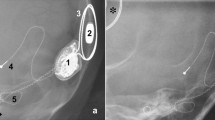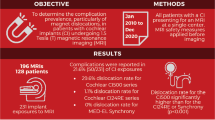Abstract
The successful outcome of a cochlear implant habilitation program depends upon a multitude of vital factors, including the avid cooperation of the cochlear implantee, committed participation of the parents/family members and total dedication of the habilitation team of implant audiologists and auditory verbal therapists. In a rare situation, where the implantee’s performance is suboptimal or poor inspite of successful implantation, anxious moments engulf the parents and the implant team, with the morbid fear of a device failure lingering at the back of their minds. We report such an incident in a 13-year-old cochlear implantee, who was an excellent cochlear implant performer for 8 years, following which she had rapid deterioration of her auditory verbal skills within the next few weeks. The hidden etiology, was the inconspicuous migration of the internal magnet of the Receiver-Stimulator Coil placed in the mastoid temporal bone of her skull, due to unexplained reasons. We share our experience with the diagnosis and management of this condition and review the existing world literature on this rarely reported entity.
Similar content being viewed by others
References
O’Donoghue, O’Neill C, Archbold SM, Nikolopoulos TP, Sach T (2002) Variation in gains in auditory performance from pediatric cochlear implantation. Otol Neurotol 23:44–48
O’Donoghue, Allen C, Nikolopoulos TP, Dyar D (2001) Reliability of a rating scale for measuring speech intelligibility after pediatric cochlear implantation. Otol Neurotol 22:631–633
Wilkinson EP, Dogru S, Meyer TA, Gantz BJ (2004) Case report: Cochlear implant magnet migration. Laryngoscope 114(11):2009–2011
Davis BM, Labadie RF, McMenomey SO, Haynes DS (2004) Cochlear implant fixation using polypropylene mesh and titanium screws. Laryngoscope 114(12): 2116–2118
Yun JM, Colburn MW, Antonelli PJ (2005) Cochlear implant magnet displacement with minor head trauma. Otolaryngol Head Neck Surg 133(2):275–277
Goycoolea MV (2005) Latin American experience with the cochlear implant. Acta Otolaryngol 125(5):468–473
Migirov L, Kronenberg J (2005) Magnet displacement following cochlear implantation. Otol Neurotol 26(4):646–648
Stokroos RJ, Van Dijk P (2007) Migration of cochlear implant magnets after head trauma in an adult and a child. Ear Nose Throat J 86(10):612–613
Tange RA, Grolman W, Carelsen B (2007) Migration of the ball electrode after cochlear implantation. Otol Neurotol 28(2):195–198
Lokman S, Bee SG, Asma A (2007) Cochlear implant magnet migration and extrusion — its treatment options. 6th APSCI Sydney Symposium Journal 118:4–7
Author information
Authors and Affiliations
Corresponding author
Rights and permissions
About this article
Cite this article
Raghunandhan, S., Krishnan, P.V., Prashanth, S. et al. Magnet migration in a cochlear implantee — a serendipitous diagnosis. Indian J Otolaryngol Head Neck Surg 62, 181–185 (2010). https://doi.org/10.1007/s12070-010-0042-4
Published:
Issue Date:
DOI: https://doi.org/10.1007/s12070-010-0042-4




